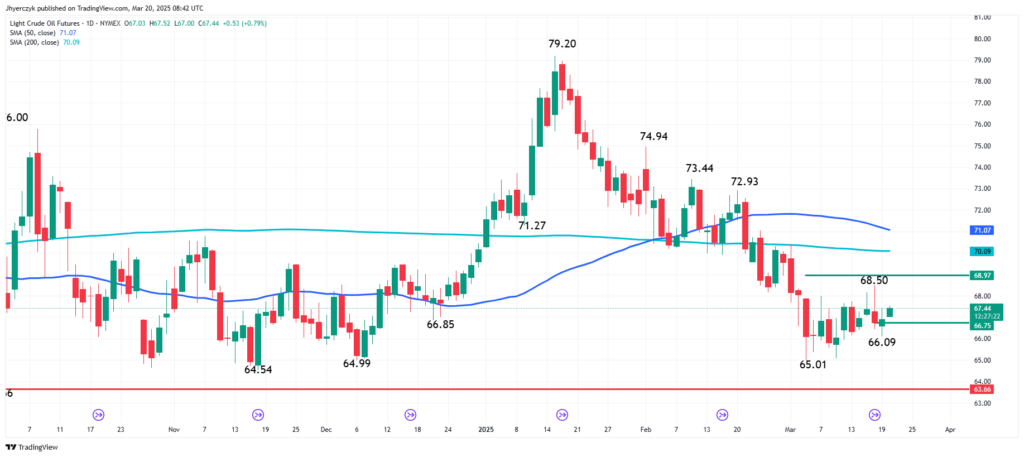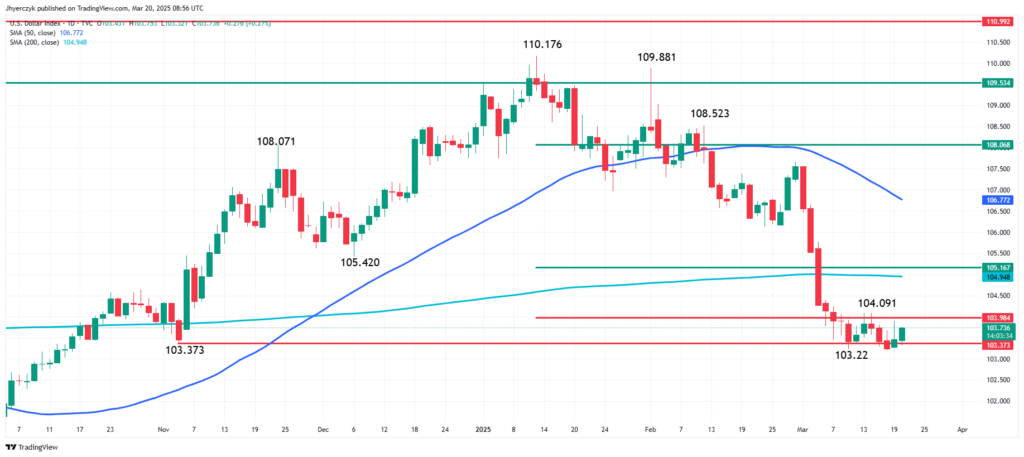Oil Prices Rise as U.S. Demand Surges—Key Resistance Levels in Focus
📌 Key Highlights:
✔ Crude oil steadies near $66.75, supported by strong U.S. fuel demand and OPEC+ supply concerns.
✔ U.S. distillate inventories drop 2.8M barrels, exceeding forecasts and signaling healthy consumption.
✔ Weaker U.S. dollar fuels crude gains, as traders anticipate potential Fed rate cuts.
✔ Geopolitical tensions add uncertainty, with OPEC+ production strategy closely watched.
✔ Crude faces resistance at $68.97 and $70.09, with downside support near $66.09.

Crude Oil Gains Momentum on Demand Strength & Dollar Weakness
Crude oil prices are climbing higher on Thursday, boosted by solid U.S. fuel demand and a declining dollar. Traders are closely monitoring a key pivot level at $66.75, which has so far acted as a base for renewed buying interest. However, upside potential remains capped by resistance at $68.97, with further hurdles at the 50-day and 200-day moving averages of $70.09 and $71.07, respectively.
⏰ As of 08:52 GMT, Light Crude Oil Futures are trading at $67.47, up $0.56 (+0.84%).
U.S. Fuel Demand Remains Strong, Boosting Prices

Daily US Dollar Index (DXY)
A sharper-than-expected decline in U.S. distillate stockpiles is supporting the oil market. According to the latest EIA data, fuel inventories dropped 2.8 million barrels, significantly outpacing the 300,000-barrel draw forecasted by analysts.
📊 What This Means for Oil Prices:
✔ Strong demand signals bullish momentum, particularly for refined products.
✔ Air travel demand lags, but broader oil consumption remains resilient.
✔ Inventory draws suggest a tight market, which could sustain higher prices.
Adding to the bullish outlook, the U.S. dollar has been in a steady decline since late February, making crude oil cheaper for international buyers. Traders are increasingly factoring in the possibility of a Fed rate cut later this year, which could further weaken the dollar and drive additional demand for crude.
Geopolitical Risks & OPEC+ Strategy Under Scrutiny
The oil market remains sensitive to ongoing geopolitical tensions:
✔ Middle East Conflicts: Israel has resumed military operations in Gaza, while the U.S. has launched airstrikes on Houthi targets in Yemen, raising concerns over supply disruptions.
✔ U.S.-Iran Tensions: Potential sanctions or conflict escalation could impact global crude flows.
✔ OPEC+ Policy Moves: The oil cartel has been curbing production to stabilize prices, but traders remain wary of a potential output increase in the coming months.
Market participants are also keeping an eye on the upcoming U.S. S&P Global Services PMI, which could offer further insights into economic growth trends and broader energy demand.
🇨🇳 China’s Oil Demand—Reality vs. Forecasts
China remains a critical factor in global oil demand projections, but recent data suggests a disconnect between expectations and actual market behavior.
✔ OPEC estimates Chinese oil demand at 16.68M barrels per day (bpd), up 320,000 bpd from last year.
✔ China’s crude imports, however, fell 2.1% YoY, dropping to 11.04M bpd.
📉 Why This Matters:
🔹 Forecasts suggest robust demand, but real-time data indicates weaker-than-expected consumption.
🔹 Lower imports could signal an inventory buildup, rather than genuine demand growth.
🔹 If Chinese consumption slows, it could cap further upside for crude prices.
Oil Market Outlook: Upside Potential vs. Resistance Zones
While near-term price action remains bullish, the $68.97 resistance level is the next key barrier. If crude breaks above, it could target $70.09 and beyond.
However, downside risks persist:
✔ Failure to hold above $66.75 could trigger a move toward $66.09 and $65.01.
✔ OPEC+ production increases may limit further price gains.
✔ Macroeconomic uncertainty could keep traders cautious.
For now, oil bulls are in control, but traders should prepare for continued volatility as global demand, monetary policy, and geopolitical factors shape market sentiment.
🚀 Stay tuned for the latest oil market updates!
⚠️ Disclaimer
This article is for informational purposes only and does not constitute financial advice. Always conduct your own research before making investment decisions.






